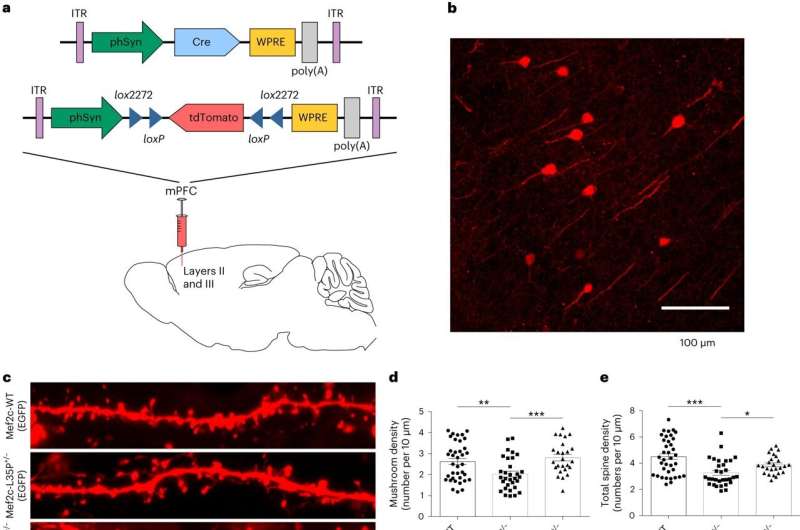December 4, 2023 report
This article has been reviewed according to Science X's editorial process and policies. Editors have highlighted the following attributes while ensuring the content's credibility:
fact-checked
peer-reviewed publication
trusted source
proofread
Altering the behavior of living mice by editing genes in the brain

Researchers at Fudan University and the Chinese Academy of Sciences, Shanghai, China, have conducted whole-brain genome editing targeted to correct a single-base mutation associated with autism spectrum disorder (ASD) in mice.
In a paper, "Whole-brain in vivo base editing reverses behavioral changes in Mef2c-mutant mice," published in Nature Neuroscience, the team details their revolutionary advancement in applied in vivo gene editing with luminous implications for clinical neuroscience.
The study focuses on a single-base mutation within the MEF2C gene, a gene associated with ASD in humans. MEF2C is highly expressed in specific brain regions (cortex, hippocampus, amygdala) and plays a crucial role in neural development and synaptic plasticity.
MEF2C gene mutations contribute to ASD as the altered gene impacts MEF2C protein stability, leading to accelerated protein degradation. With a critical protein involved in neuronal structure compromised, abnormal neuronal morphologies form, causing developmental deficits like intellectual disability, lack of speech, and repetitive behaviors.
To enact a change in the mutated genes configuration, the team developed a base editing system called the AeCBE system (Apolipoprotein B mRNA-Editing Enzyme, Catalytic Polypeptide-embedded Cytosine Base Editor) to convert C·G to T·A base pairs without causing double-stranded DNA breaks. By not allowing a double-stranded break, the method reduces the chances of indels, unplanned additions or deletions.
In experimentation, mice with the Mef2cL35P mutation exhibited behavioral abnormalities mimicking ASD traits like hyperactivity, repetitive behavior, and social abnormalities. Injecting AeCBE via blood-brain barrier-crossing with an adeno-associated virus successfully corrected the mutation in the mouse brain, restoring Mef2c protein levels in various brain regions and reversing behavioral abnormalities.
The findings provide a promising result for potential therapeutic approaches in treating genetic brain disorders caused by single-gene mutations. The method's success in living mice highlights its clinical relevance in addressing genetic neurodevelopmental disorders in humans.
More information: Wei-Ke Li et al, Whole-brain in vivo base editing reverses behavioral changes in Mef2c-mutant mice, Nature Neuroscience (2023). DOI: 10.1038/s41593-023-01499-x
© 2023 Science X Network





















